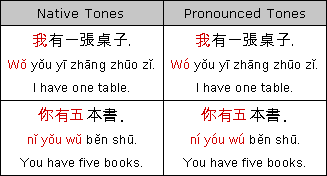





In some cases, characters aren't pronounced with their "native" tones (the tones assigned to them). Here are three cases where tones experience shifts.
In spoken Mandarin, third tone characters are actually seldom pronounced in the third tone. Unless they occur alone, or come at the very end of a sentence, they're subject to a tone shift rule.
The first "shift" occurs when two or more third tone characters occur consecutively. What happens is this:
When two or more third tone characters occur in a row, the last of these remains a third tone, while the one(s) before it are pronounced in, or shift to, the second tone. In this illustration, the characters that experience tone shifts are colored red to help you pick them out. Notice that the final third tone in each series remains a third tone.

As it happens, the final third tones in both these examples would be pronounced as "partial" third tones. Let's discuss that next.
This next shift rule applies when any of the other tones (first, second, fourth, or neutral) comes after a third tone. In this case the third tone doesn't actually shift to another tone, but rather mutates to a "partial third" tone, which means that it begins low and dips to the bottom, but then doesn't rise back to the top. Compare it here to the full third tone:
|
|
The character
(bù), which means no or not, is normally a fourth tone character,
but when it comes before another fourth tone character, it
shifts to the second tone.
Therefore, instead of saying bù shì and bù yaò, you would say bú shì and bú yaò. You'll see a reminder of this in the Grammar section.
These are principles that will slow down your speech at first, as you back up to apply the shifts to words you just spoke incorrectly, but just give them time. They too will eventually become second nature.
NOTEFrom here, you can view all the romanization and pinyin initial/final tables, or skip ahead to some listening recommendation to close out this pronunciation section.